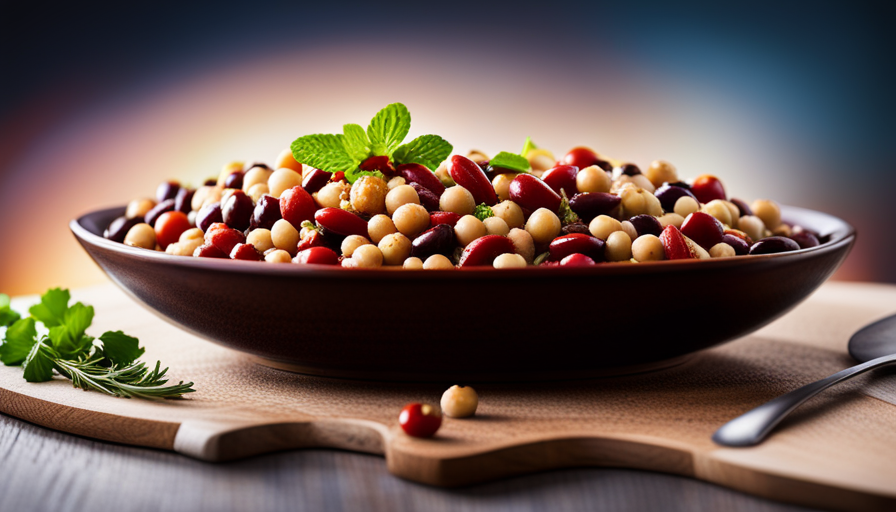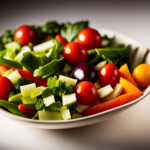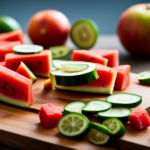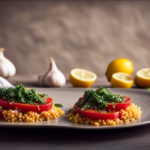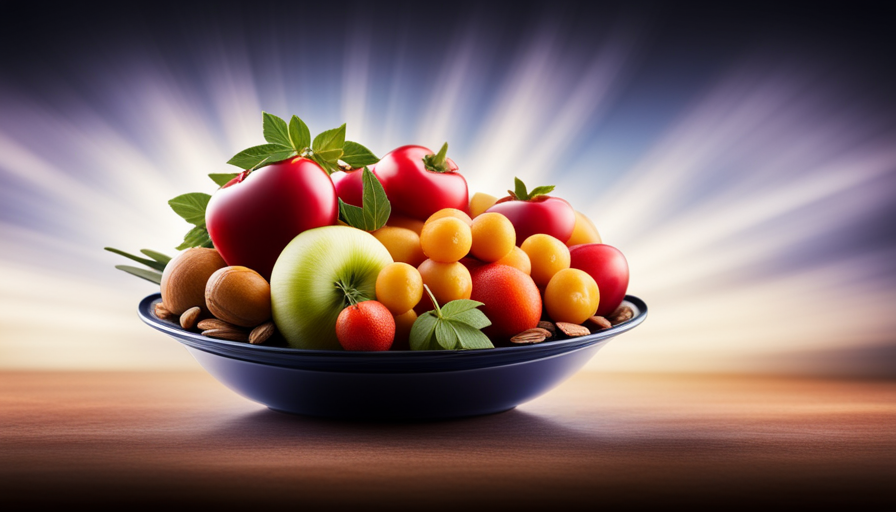Tired of the boring flavor of raw food? Craving the deliciousness of cooked dishes but still want to keep the health benefits of raw food? Look no further! This article will explore various techniques and ingredients to elevate your raw food to a whole new level of cooked-like taste sensation.
Using marinades and sauces is a simple yet effective way to enhance the flavors of raw food. From tangy citrus marinades to rich and savory barbecue sauces, these flavor-boosting additions will take your taste buds on a culinary journey.
Incorporating smoked ingredients adds a smoky flavor that is often associated with cooked food. Whether it’s smoked paprika, liquid smoke, or even smoked salt, these ingredients bring a whole new dimension to your raw dishes.
But who says you need heat to cook? Heat-free cooking techniques like dehydrating and sous vide can transform the texture and taste of your raw ingredients, giving them a cooked-like quality.
Stay tuned as we dive deeper into the world of raw food flavor enhancement. From aromatics and spices to fermentation and nutritional yeast, we will explore a multitude of techniques and ingredients that will elevate your raw food experience.
So get ready to embark on a delicious journey and discover the secrets to giving raw food a cooked flavor like never before!
Key Takeaways
- Techniques like marinating, fermenting, and dehydrating can be used to give raw food a cooked flavor.
- Incorporating smoked ingredients can add a smoky flavor to raw dishes.
- Using marinades and sauces can enhance the flavors of raw food.
- Aromatics, spices, and umami-rich ingredients can be used to add depth and complexity to raw dishes.
Using Marinades and Sauces for Flavor Enhancement
If you want to elevate the taste of your raw food to a whole new level, using marinades and sauces is the secret to achieving that mouthwatering cooked flavor you crave.
Marinades are a great way to infuse your raw food with flavors and aromas that mimic the deliciousness of cooking. One popular option is smoky marinades, which can give your raw food a charred, grilled taste. These marinades often contain ingredients like liquid smoke, paprika, and garlic powder, which lend a smoky, savory flavor to your dish.
Fermented sauces are another fantastic option for adding cooked flavor to raw food. These sauces are made by fermenting ingredients like vegetables, fruits, or even fish. During the fermentation process, enzymes and bacteria break down the ingredients, releasing complex flavors and transforming them into tangy, umami-rich condiments. Examples of fermented sauces include soy sauce, fish sauce, and kimchi. Adding a spoonful of these sauces to your raw food can instantly enhance its taste, giving it a depth and complexity that is reminiscent of cooking.
Using smoky marinades and fermented sauces is a surefire way to give your raw food the cooked flavor you desire. Experiment with different marinades and sauces to find the combination that best suits your taste buds. With a little creativity and the right ingredients, you can enjoy the mouthwatering flavors of cooked food, even when eating raw.
Incorporating Smoked Ingredients for a Smoky Flavor
Embrace the smoky essence by infusing your dishes with the distinct flavors of smoked ingredients. Achieving a smoky flavor in raw food may seem challenging, but with the right techniques, you can recreate that delicious, cooked taste.
Here are some tips to help you incorporate smoky flavors into your dishes:
-
Grilling techniques for a smoky flavor: Grill your raw ingredients over a charcoal or wood fire to impart a smoky taste. The heat and smoke from the grill will add depth and complexity to your dish. Use indirect grilling for larger cuts of meat or vegetables that require longer cooking times.
-
Incorporating wood chips for an added smoky taste: Soak wood chips, such as hickory, mesquite, or applewood, in water for about 30 minutes. Drain the chips and place them in a smoker box or wrap them in aluminum foil perforated with small holes. Place the wood chips directly on the grill or in a smoker box to release their smoky flavor as they heat up.
By following these grilling techniques and incorporating wood chips, you can give your raw food a delicious, cooked flavor with a hint of smokiness. Experiment with different types of wood chips and grilling methods to discover your favorite smoky combinations.
Applying Heat-Free Cooking Techniques
Try out heat-free cooking techniques to add a unique twist to your dishes – who knew you could create delicious meals without even turning on the stove? Heat-free cooking techniques are a great way to explore raw food recipes and add a cooked flavor to your meals.
One technique to try is marinating. Marinating involves soaking food in a flavorful liquid, such as a mixture of herbs, spices, and citrus juice, to infuse it with flavor. This technique works well for vegetables, tofu, and even fruits.
Another heat-free cooking technique to consider is fermenting. Fermentation involves allowing natural bacteria to break down sugars and transform them into acids, creating complex flavors. Fermented foods like sauerkraut, kimchi, and pickles can add a tangy and savory element to your dishes.
Lastly, dehydration is a heat-free technique that can intensify flavors. By removing the water content from food, you can concentrate its taste. You can dehydrate fruits to create chewy snacks or vegetables to make crunchy chips.
Overall, heat-free cooking techniques provide a creative way to enhance the flavors of raw food and give it a cooked taste without using any heat.
Utilizing Aromatics and Spices to Add Depth
Enhance your culinary creations by incorporating aromatic herbs and spices, infusing your dishes with a tantalizing depth of flavor. When it comes to giving raw food a cooked flavor, one effective technique is to use flavorful rubs and blends. These combinations of herbs, spices, and other ingredients can be applied to raw ingredients to enhance their taste and mimic the flavors of cooked food.
One approach is to create a dry rub by mixing together herbs, spices, salt, and pepper. This mixture can then be rubbed onto meats, vegetables, or even fruit, adding a savory and aromatic element. For example, a blend of paprika, cumin, garlic powder, and dried herbs can transform a simple raw vegetable salad into a flavorful and satisfying dish.
Another way to add depth to raw food is by incorporating citrus and acidic ingredients. The tangy flavors of lemon, lime, vinegar, or even fermented foods can help balance out the rawness and bring a bright and refreshing twist. Squeezing some fresh lemon juice over raw fish or adding a splash of vinegar to a raw vegetable slaw can elevate the flavors and make them more complex.
By experimenting with flavorful rubs and blends, as well as incorporating citrus and acidic ingredients, you can give your raw dishes a cooked flavor that will surprise and delight your taste buds. So, don’t be afraid to get creative and explore the world of herbs, spices, and other aromatic ingredients to take your culinary creations to the next level.
Experimenting with Fermentation for Umami Flavors
Explore the world of fermentation to unlock the rich and savory umami flavors waiting to transform your culinary creations. Fermentation techniques have been used for centuries to preserve food, but they also have the power to enhance flavors and create unique taste profiles. By harnessing the power of microorganisms, you can take raw ingredients and infuse them with complex, savory notes that rival the depth of cooked food.
When it comes to fermenting ingredients for umami flavors, there are endless possibilities. One popular technique is lacto-fermentation, which involves the use of lactic acid bacteria to break down sugars and create tangy and savory flavors. This process can be used with a variety of vegetables such as cabbage, carrots, and radishes, resulting in delicious fermented vegetables like sauerkraut and kimchi.
To give you a better idea of the potential of fermentation, here is a table showcasing some umami rich ingredients and the fermentation techniques that can be used to unlock their flavors:
| Ingredient | Fermentation Technique | Resulting Flavor |
|---|---|---|
| Soybeans | Soy Sauce Fermentation | Salty and savory |
| Fish | Fish Sauce Fermentation | Rich and pungent |
| Mushrooms | Mushroom Fermentation | Earthy and meaty |
By experimenting with fermentation techniques and umami rich ingredients, you can bring a cooked flavor to raw food. Whether it’s through lacto-fermentation or other methods, the world of fermentation offers a multitude of opportunities to elevate your dishes to a new level of taste and complexity. So go ahead, embrace the power of fermentation and unlock the umami secrets of raw food.
Adding Texture and Crunch with Dehydrated Ingredients
To add an exciting crunch and texture to your dishes, you can experiment with dehydrated ingredients like kale chips. Imagine biting into a perfectly crispy and flavorful kale chip that adds a satisfying crunch to your salad, creating a delightful contrast of textures in every bite.
Dehydrating ingredients is a great technique to enhance the taste and texture of raw food while still maintaining its nutritional value. Crispy toppings can be created by dehydrating various vegetables, fruits, and even herbs. For example, thinly sliced zucchini can be dehydrated until it becomes crispy and can be used as a topping for salads or soups. Dehydrated tomatoes can be crushed into flakes to add a burst of flavor and crunch to your dishes.
Flavor-infused powders can also be made by dehydrating certain ingredients. By dehydrating herbs like basil or mint, you can create a powder that can be sprinkled on top of your raw dishes to give them a cooked flavor. Additionally, dehydrated mushrooms can be ground into a powder to add a savory umami taste to your meals.
Incorporating dehydrated ingredients into your raw food recipes allows you to elevate the texture and taste, giving them a cooked-like experience. So go ahead, experiment with dehydrating ingredients and enjoy the satisfying crunch and flavor they bring to your dishes.
Infusing Flavors with Infused Oils and Vinegars
Indulge your taste buds with the rich and vibrant flavors that can be achieved by infusing oils and vinegars, adding a tantalizing depth to your dishes. Infusing herbs, fruits, and even vegetables into oils and vinegars can create unique and exciting flavors that will elevate your raw food to a whole new level.
Here are four ways you can infuse oils and vinegars to add depth and complexity to your dishes:
-
Infusing herbs: By steeping fresh herbs like basil, rosemary, or thyme in oil or vinegar, you can extract their aromatic flavors and create a delightful infusion. These herb-infused oils and vinegars can be used as a base for dressings, marinades, or simply drizzled over your dishes for an extra burst of freshness.
-
Infusing fruits for unique flavors: Experiment with infusing fruits like citrus, berries, or even tropical fruits into oils and vinegars. This process allows the natural sweetness and tanginess of the fruits to infuse into the liquid, resulting in a burst of fruity flavor. Try using lemon-infused oil for a zesty kick or raspberry-infused vinegar for a touch of sweetness.
-
Using flavored salts for a burst of taste: Flavored salts, such as garlic salt, chili salt, or truffle salt, can instantly add a burst of taste to your dishes. Sprinkle a pinch of flavored salt over your raw food creations to enhance their flavors and give them a cooked-like taste.
Incorporating these infused oils, vinegars, and flavored salts into your raw food recipes will bring a depth of flavor that will surprise and delight your taste buds. Experiment with different combinations and let your creativity run wild as you explore the world of infused oils and vinegars.
Using Seasonings and Herbs for Flavor Enhancement
Enhance your dishes with a tantalizing array of seasonings and herbs, infusing them with a burst of flavor that’ll leave your taste buds craving more.
Using herbs as natural flavor enhancers is a fantastic way to give your raw food a cooked flavor. Herbs such as basil, rosemary, thyme, and oregano can add depth and complexity to your dishes. These herbs not only provide a burst of flavor, but they also offer numerous health benefits.
Exploring different seasoning combinations can take your raw food to the next level. Combining herbs and spices like garlic, onion powder, paprika, and cumin can create a unique flavor profile that transforms your dishes. Experimenting with different ratios and combinations will allow you to find the perfect blend that suits your taste preferences.
When using herbs and seasonings, it’s essential to understand their individual flavors and the dishes they pair well with. For example, rosemary works great with roasted vegetables, while basil complements tomatoes and pasta dishes. By understanding these flavor profiles, you can create harmonious combinations that enhance the natural taste of your raw food.
Using herbs as natural flavor enhancers and exploring different seasoning combinations can give your raw food a cooked flavor that’s both delicious and satisfying. So go ahead, experiment with different herbs and seasonings, and let your taste buds embark on a flavorful journey.
Incorporating Nutritional Yeast for a Cheesy Taste
Experience the savory delight of nutritional yeast, a cheesy alternative that adds a burst of umami to your dishes, with its unique flavor profile reminiscent of aged Parmesan cheese. Incorporating nutritional yeast for a cheesy taste, without using marinades and sauces, can elevate your raw food recipes to new heights.
Here are some raw food recipes and food pairings that highlight the umami flavors of nutritional yeast:
-
Raw Zucchini Pasta with Nutritional Yeast: Create a raw pasta dish by spiralizing zucchini noodles and tossing them with a sprinkle of nutritional yeast. The creamy and cheesy flavor of the yeast will perfectly complement the freshness of the zucchini.
-
Raw Cauliflower Popcorn with Nutritional Yeast: Cut cauliflower into bite-sized florets and toss them in a bowl with nutritional yeast, salt, and pepper. Then, dehydrate them until they become crispy. This raw twist on a classic snack will satisfy your cravings for cheesy goodness.
-
Raw Cashew Cheese Spread: Blend soaked cashews with nutritional yeast, lemon juice, garlic, and a pinch of salt to create a creamy and tangy cheese spread. This versatile spread can be enjoyed on crackers, as a dip, or even as a base for raw pizza.
-
Raw Vegan Mac and Cheese: Create a creamy ‘cheese’ sauce by blending soaked cashews, nutritional yeast, miso paste, lemon juice, and a hint of turmeric for color. Toss the sauce with raw zucchini or kelp noodles for a comforting and satisfying meal.
Incorporating nutritional yeast into your raw food recipes allows you to enjoy a cheesy taste without relying on marinades and sauces. Experiment with these recipes and food pairings to discover the full potential of nutritional yeast’s umami flavors.
Exploring Raw Food Recipes and Food Pairings
Unleash your culinary creativity with these tantalizing raw recipes and inventive flavor combinations. When it comes to raw food nutrition, it’s important to not only focus on the health benefits but also on the taste. By exploring different raw food recipes and food pairings, you can give your raw dishes a cooked flavor that will leave your taste buds satisfied.
One way to enhance the flavors of raw food is by experimenting with creative plating ideas. By combining different textures, colors, and flavors, you can create visually appealing dishes that are as delicious as they are nutritious. For example, pairing a creamy avocado with crunchy sprouts and tangy citrus can create a refreshing and well-balanced dish.
To further elevate the taste of raw food, consider incorporating a variety of herbs and spices. These can add depth and complexity to your dishes, mimicking the flavors that are typically associated with cooking. Some popular choices include garlic, ginger, cumin, turmeric, and paprika.
To give you a better idea of how to pair different ingredients, here is a table that showcases some creative raw food combinations:
| Main Ingredient | Pairing Ingredient 1 | Pairing Ingredient 2 |
|---|---|---|
| Watermelon | Feta cheese | Fresh mint |
| Zucchini noodles | Tomato | Basil |
| Cauliflower rice | Lemon zest | Parsley |
By utilizing raw food recipes and exploring inventive flavor combinations, you can give your dishes a cooked flavor that will satisfy your taste buds while still reaping the benefits of raw food nutrition. Get creative and enjoy the process of discovering new and delicious ways to enjoy raw food!
Frequently Asked Questions
Can you use marinades and sauces on raw food to give it a cooked flavor?
Yes, marinades and sauces can definitely be used to give raw food a cooked flavor. Marinades infuse raw food with flavor by using ingredients like acids, oils, aromatics, spices, and sometimes fermented liquids.
Sauces, on the other hand, are often made by cooking ingredients together to create complex flavors. Additionally, techniques like smoking can be used to impart a cooked flavor to raw food by exposing it to the aroma and taste of smoke.
These flavoring techniques help enhance the umami flavors in raw food, giving it a delicious cooked taste.
How can you incorporate smoked ingredients into raw food to achieve a smoky flavor?
To achieve a smoky flavor in raw food, you can explore alternative options instead of relying on traditional cooking methods. One interesting statistic is that smoked ingredients can enhance the taste of raw food by infusing it with a rich, smoky essence.
You can experiment with techniques such as using smoked spices, liquid smoke, or even smoking the food using a cold-smoking technique. These methods can add depth and complexity to your raw dishes, creating a unique sensory experience.
What are some heat-free cooking techniques that can be used to give raw food a cooked flavor?
To preserve raw food while giving it a cooked flavor, explore dehydrating techniques. Dehydration removes moisture from food, concentrating its flavors and creating a chewy texture. By using a dehydrator or an oven set to low heat, you can achieve a cooked-like taste without actually cooking the food.
Dehydrating also enhances the natural sweetness of fruits and vegetables, making them more enjoyable to eat. Experiment with different seasonings and spices to further enhance the cooked flavor of your dehydrated raw food.
How can aromatics and spices be used to add depth to raw food dishes?
To add depth to raw food dishes, start by using a variety of herbs and seasonings. These ingredients have powerful flavors that can enhance the taste of raw ingredients.
Additionally, incorporating citrus fruits and vinegars can add a tangy element to your recipes. Citrus fruits, such as lemon or lime, provide a burst of freshness, while vinegars, like balsamic or apple cider, offer a unique acidity.
Experimenting with different combinations of aromatics and spices will help elevate the flavors in your raw food dishes.
What are some ways to experiment with fermentation to achieve umami flavors in raw food recipes?
To achieve umami flavors in raw food recipes, you can experiment with various fermentation techniques. Fermentation can enhance the depth and complexity of flavors in raw ingredients.
Try fermenting vegetables, such as cabbage for sauerkraut or cucumbers for pickles, using salt or a starter culture. These methods promote the growth of beneficial bacteria, which produce umami compounds.
Additionally, fermenting soybeans can yield miso or soy sauce, both of which add a rich umami taste to raw dishes.
Can the process of giving raw food a cooked flavor be applied to spicy foods like raw jalapenos?
Yes, the process of giving raw food a cooked flavor can improve spicy food tolerance. For raw jalapenos, techniques like roasting or pickling can mellow the heat while developing a richer flavor. Experiment with different methods to find the best way to enhance the tolerance for spicy foods.
Conclusion
In conclusion, by incorporating these techniques and ingredients into your raw food preparation, you can elevate the flavors and textures, giving them a cooked-like experience. It’s like adding a dash of magic to your plate, transforming simple ingredients into a culinary masterpiece.
So go ahead and experiment with marinades, spices, and fermentation to unlock a whole new world of taste sensations. With a little creativity and a willingness to explore, you’ll be amazed at the depth and complexity you can achieve in your raw food creations.
Bon appétit!


